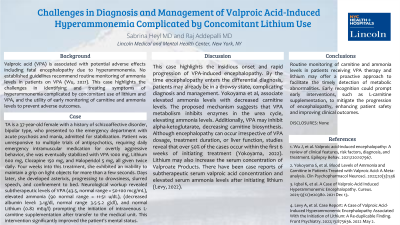Neurocognitive Disorders and Neuropsychiatry
(087) Challenges in Diagnosis and Management of Valproic Acid-Induced Hyperammonemia Complicated by Concomitant Lithium Use


Sabrina Heyl, MD (she/her/hers)
PGY2
Lincoln Medical Center
new york, New York- RA
Raj Addepalli, MD
Attending Psychiatrist
Lincoln Hospital
Bronx, New York
Presenting Author(s)
Co-Author(s)
Background
Valproic acid (VPA) is associated with potential adverse effects including fatal encephalopathy due to hyperammonemia. No established guidelines recommend routine monitoring of ammonia levels in patients on VPA (Wu, 2021). This case highlights the challenges in identifying and treating symptoms of hyperammonemia complicated by concomitant use of lithium and VPA, and the utility of early monitoring of carnitine and ammonia levels to prevent adverse outcomes. Case TA is a 37-year-old female with a history of schizoaffective disorder, bipolar type, who presented to the emergency department with acute psychosis and mania, admitted for stabilization. Patient was unresponsive to multiple trials of antipsychotics, requiring daily emergency intramuscular medication for overtly aggressive behavior, she was eventually stabilized with VPA 1000 mg, Lithium 600 mg, Clozapine 150 mg, and Haloperidol 5 mg, all given twice daily. Four weeks into this treatment, she exhibited an inability to maintain a grip on light objects for more than a few seconds. Days later, she developed asterixis, progressing to drowsiness, slurred speech, and confinement to bed. Neurological workup revealed subtherapeutic levels of VPA (43.5, normal range = 50-100 mcg/mL), elevated ammonia (90 normal range = 11-51 µ/dL), (decreased albumin level: 3.1g/dl, normal range 3.5-5.2g/dl), and normal Lithium (0.82 meq/l) prompting the initiation of intravenous L-carnitine supplementation after transfer to the medical unit. This intervention significantly improved the patient's mental status. Discussion This case highlights the insidious onset and rapid progression of VPA-induced encephalopathy. By the time encephalopathy enters the differential diagnosis, patients may already be in a drowsy state, complicating diagnosis and management. Yokoyama et al, associate elevated ammonia levels with decreased carnitine levels. The proposed mechanism suggests that VPA metabolism inhibits enzymes in the urea cycle, elevating ammonia levels. Additionally, VPA may inhibit alpha-ketoglutarate, decreasing carnitine biosynthesis. Although encephalopathy can occur irrespective of VPA dosage, treatment duration, or liver function, studies reveal that over 50% of the cases occur within the first 6 weeks of initiating treatment (Yokoyama, 2022). Lithium may also increase the serum concentration of Valproate Products. There have been case reports of subtherapeutic serum valproic acid concentration and elevated serum ammonia levels after initiating lithium (Levy, 2022). Conclusion Routine monitoring of carnitine and ammonia levels in patients receiving VPA therapy and lithium may offer a proactive approach to facilitate the timely detection of metabolic abnormalities. Early recognition could prompt early interventions, such as L-carnitine supplementation, to mitigate the progression of encephalopathy, enhancing patient safety and improving clinical outcomes. References
1. Wu J, et al. Valproic acid-induced encephalopathy: A review of clinical features, risk factors, diagnosis, and treatment. Epilepsy Behav. 2021;120:107967.
2. Yokoyama S, et al. Blood Levels of Ammonia and Carnitine in Patients Treated with Valproic Acid: A Meta-analysis. Clin Psychopharmacol Neurosci. 2022;20(3):536-547.
3. Iqbal K, et al. A Case of Valproic-Acid Induced Hyperammonemic Encephalopathy. Cureus. 2021;13(12):e20380. 2021 Dec 13.
4. Levy A, et al.
Case Report: A Case of Valproic Acid-Induced Hyperammonemic Encephalopathy Associated With the Initiation of Lithium: A Re-duplicable Finding. Front Psychiatry. 2022;13:875636. 2022 May 2.
Presentation Eligibility: Not previously published or presented
Diversity, Equity, and Inclusion: This case underscores the vital need for tailored medical approaches and proactive monitoring in patients receiving multiple psychiatric medications. Such measures are essential to ensure equitable access to safe and effective treatment for every individual, irrespective of their unique medical needs or circumstances.

